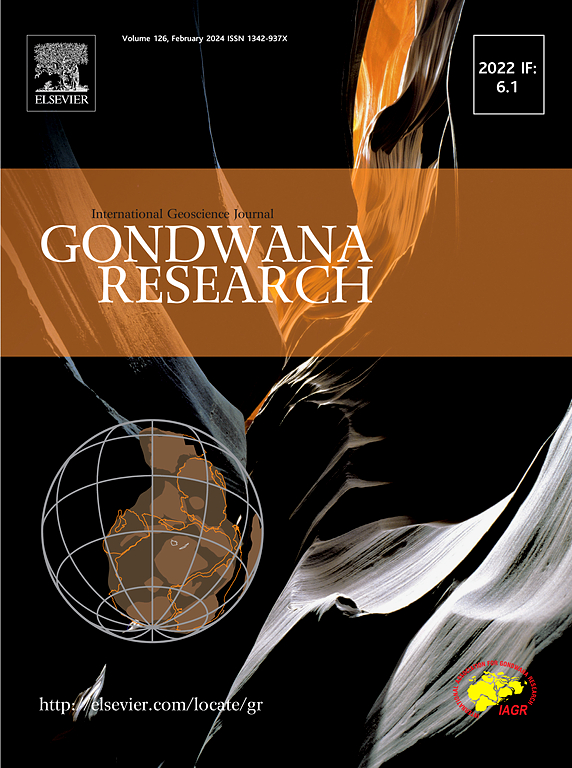Origin of superlarge Bayan Obo carbonatite body and its REE-Nb mineralization
IF 7.2
1区 地球科学
Q1 GEOSCIENCES, MULTIDISCIPLINARY
引用次数: 0
Abstract
Mantle-derived carbonatites provide the most rare earth element (REE) and Nb metal raw materials for the global market. Among them, the Bayan Obo in China is a huge carbonatite body containing the world’s largest REE and second-largest Nb resources. However, neither the origin of the superlarge carbonatite nor of the REE and Nb mineralization are known. Here, we report the first Bayan Obo primary carbonatites with monazite and columbite U-Pb ages of ca. 1300 Ma. They show moderate REE and relatively high Nb contents and mantle-derived depleted 87Sr/86Sri (0.70255–0.70298), εNdt (0.2–2.2) isotopic values, distinct from the (ca. 433–408 Ma REE mineralization) banded rocks that have radiogenic Sr isotopes (up to 0.7060). Many REE and Nb minerals are veinlets or overprints in the banded rocks. Two types of δ13C (∼−4.2 ‰ and −0.16 – 0.29 ‰) isotopes with less radiogenic Sr (∼0.7030) isotopic values were identified in the carbonatites. They may represent different C sources involving interactions between a subducted C-bearing mantle source and an upwelling Mesoproterozoic plume. Therefore, we infer that the Paleoproterozoic assembly and Mesoproterozoic breakup of the Columbia supercontinent favored precursory mantle carbon enrichment and subsequent melting to generate a giant carbonatite with initial REE and Nb mineralization. External fluid alteration re-enriched REE and remobilized Nb.

白云鄂博超大碳酸盐岩成因及稀土铌矿化
地幔源碳酸盐为全球市场提供了最多的稀土元素(REE)和铌金属原料。其中,中国白云鄂博是一个巨大的碳酸盐岩体,稀土储量居世界第一,铌储量居世界第二。然而,超大型碳酸盐岩的成因和稀土、铌矿化均不清楚。本文报道了白云鄂博第一批原生碳酸盐岩,其U-Pb年龄约为1300 Ma。其稀土元素含量适中,Nb含量较高,幔源贫化87Sr/86Sri (0.70255 ~ 0.70298), εNdt(0.2 ~ 2.2)同位素值与放射性成因Sr同位素(约433 ~ 408 Ma REE矿化)的带状岩石不同(高达0.7060)。许多稀土和铌矿物在带状岩石中呈细脉状或叠层状。碳酸盐岩中存在两种δ13C(~ - 4.2‰和- 0.16 ~ 0.29‰)同位素,Sr(~ 0.7030)同位素值较低。它们可能代表不同的碳源,包括俯冲的含碳地幔源和上涌的中元古代地幔柱之间的相互作用。因此,我们推断,哥伦比亚超大陆的古元古代拼合和中元古代断裂有利于早期地幔碳富集和随后的熔融,形成具有初始REE和Nb矿化的巨型碳酸盐岩。外部流体蚀变使稀土元素再富集,铌元素再活化。
本文章由计算机程序翻译,如有差异,请以英文原文为准。
求助全文
约1分钟内获得全文
求助全文
来源期刊

Gondwana Research
地学-地球科学综合
CiteScore
12.90
自引率
6.60%
发文量
298
审稿时长
65 days
期刊介绍:
Gondwana Research (GR) is an International Journal aimed to promote high quality research publications on all topics related to solid Earth, particularly with reference to the origin and evolution of continents, continental assemblies and their resources. GR is an "all earth science" journal with no restrictions on geological time, terrane or theme and covers a wide spectrum of topics in geosciences such as geology, geomorphology, palaeontology, structure, petrology, geochemistry, stable isotopes, geochronology, economic geology, exploration geology, engineering geology, geophysics, and environmental geology among other themes, and provides an appropriate forum to integrate studies from different disciplines and different terrains. In addition to regular articles and thematic issues, the journal invites high profile state-of-the-art reviews on thrust area topics for its column, ''GR FOCUS''. Focus articles include short biographies and photographs of the authors. Short articles (within ten printed pages) for rapid publication reporting important discoveries or innovative models of global interest will be considered under the category ''GR LETTERS''.
 求助内容:
求助内容: 应助结果提醒方式:
应助结果提醒方式:


